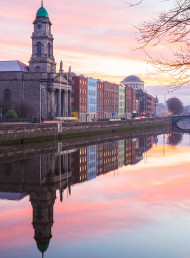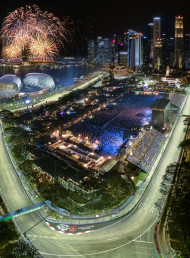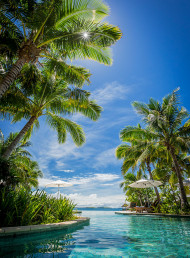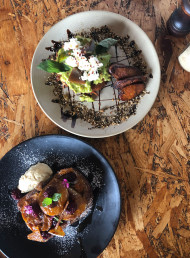You thought you knew Macau

A food lover’s paradise with a diverse cultural history, Macau offers much more than its reputation as just a gambler’s playground.
Mention Macau and the response is generally: “that’s the gambling place, isn’t it?”. Dubbed ‘The Vegas of China’, Macau is home to more than 41 casinos making it the biggest gaming centre in the world. And a skyline view shows more are being built, along with the prerequisite hotels and malls.
This place is certainly booming, and its economic prosperity does rest heavily on the roll of the dice. According to the New York Times, Macau “surpassed the Las Vegas Strip to become the world’s biggest gambling centre in 2006.” It is the only place in China where gambling is legal.
But gaming was not always its beating heart. Macau’s Chinese and Portuguese heritage and trading past means it’s home to many diverse cultures and cuisines.
Some of the earliest settlers in Macau were fisher people from the Guangdong province of China. Because of its location at the mouth of the Pearl River Delta it was a thriving port on the ancient Silk Road. It was known to the Chinese as OuMun (‘trading gate’) and A-Ma-Gao (‘place of A-Ma’) in honour of A-Ma, the Chinese goddess of sailors. Portuguese traders arrived in the 1550s and quickly put down roots there. Portugal’s dominance continued for more than 400 years and it became known as Macau (aka Macao). It developed into an important and prosperous trading centre predominantly for Europe, India, China and Japan and was seen as ‘the crossroads for the meeting of East and West cultures’.
The British victory over China in the 1814 Opium War enabled its neighbour Hong Kong to become the bigger port in the region and Macau temporarily mellowed into a sleepy town. In 1999, administration was handed back from Portugal to China and today it remains – like Hong Kong – a Specialist Administrative Region (SAR) of China.
About 60km south west of Hong Kong, Macau is made up of the city of Macau – which is built on a peninsula – and the two islands of Taipa and Coloane, all linked by two bridges and a causeway. In October of this year, a third bridge – the world’s largest sea bridge, which links Macau and Hong Kong to the Chinese mainland, opened. The US$20 billion Hong Kong-Zuhai-Macau Bridge spans 55km and includes a section that dips into an undersea tunnel.

In 2005, the Historic Centre of Macau was listed as a UNESCO World Heritage Site and it is UNESCO’S Creative City for Gastronomy 2018. Its wealth has also attracted global fashion and retail brands, creating both a shopper’s nirvana within this small territory and yet another reason to rethink Macau.
Day tripping
One of Macau’s charms is the juxtaposition between the historic buildings that reflect the architectural styles of its multi-faceted heritage and the masterpieces of modern architecture and tall skyscrapers that they now sit amongst.
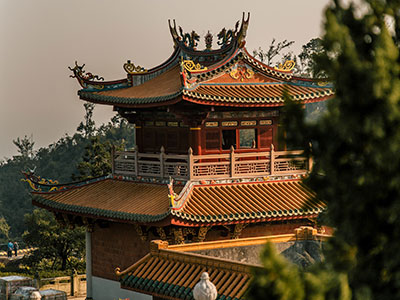
Alongside trading, Macau also became central to Christianity in Asia, with the Roman Catholic church establishing its roots here. There are a number of historic churches worth visiting, but the ruins of St Paul’s have become a Macau icon. The beautiful façade is all that remains of the first church and college of the Jesuit order in China after a fire destroyed the rest in 1835. St Lawrence’s church in Lilau Square is also significant. Built by the Jesuits in the mid-1600s, the current iteration was completed around 1846. Its large size and interiors reflect the area’s former status as one of the wealthiest parts of the city.
The A-Ma Temple is the oldest temple and is reputed to be the longest surviving building in Macau. A UNESCO World Heritage Site, it consists of six parts. As the Macau Tourism office explains, “the variety of pavilions dedicated to the worship of different deities in a single complex make A-Ma Temple an exemplary representation of Chinese culture”.

Walk through the Luis de Camoes Gardens to see a gentler, greener part of the city. Named after the Portuguese poet, the gardens are popular with locals who come for tai chi, badminton and to socialise.
Where to sleep in Macau
In March 2018, the Census Economic Information Centre (CEIC) recorded 115 hotels in Macau with some 38,600 rooms – and more are being built. These range from five-star masterpieces right down to those for the more budget conscious, so finding one to fit your requirements is not hard. While most hotels in Macau are attached to a casino, plenty also offer family attractions including playgrounds and kids’ clubs. Here are two that dish stayed at.
1. Hotel Okura Macau
Part of the Japanese Okura Hotel chain, Hotel Okura Macau epitomises the ‘harmonious combination of functionality and comfort’ that its parent brand aims to achieve. With 429 rooms and 59 suites, it’s considered on the smaller side by Macau’s hotel standards, which is refreshing if that’s more your thing. Nevertheless, its location within the Galaxy Macau mega-complex means restaurants, hotels, casinos, food halls, spas and shops are all on your doorstep. A stay at the Okura therefore affords access to the Galaxy’s fabulous Grand Resort Deck with its 575m-long Syktop River Ride and Skytop Wave Pool (both the world’s largest). There is also Kidz Island aquatic play area and the Skytop Waterslide, making it a great hotel choice for families. Recreational facilities include an indoor swimming pool and gym – an extra enticement to the latter is that a run on the treadmill is rewarded by panoramic views across the river to mainland China.
2. The Legend Palace Hotel
This recently opened hotel is five-star: luxurious and grand. Situated at the Fisherman’s Wharf complex, it’s a two-minute walk from the ferry terminal. Rooms have their own balcony with views over the city – the casinos’ preponderance for massive exterior signage in flashing neon makes the city’s night views spectacular. Expect all the mod cons along with high thread count linen, plush carpet, heavy drapes, soft bathrobes and sumptuous bathrooms. Indulge in a foot massage at the Senses Heal th Club for a glorious way to wind down after shopping.
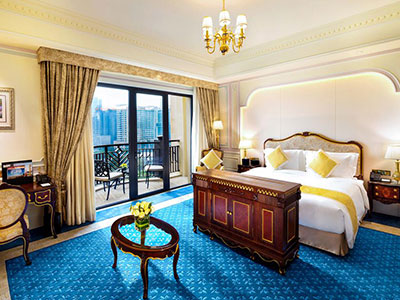
What to eat in Macau
Eating is a big deal in Macau and food is certainly giving the country’s gambling reputation a run for its money. It’s a foodie’s paradise with a multitude of cuisines on offer and gourmet experiences that range from fine-dining to street stall.
Restaurante Litoral
Dubbed the “first fusion cuisine in Asia”, Macanese food is unique to Macau and evolved principally from the combination of Portuguese and Chinese cooking, as settlers from Portugal endeavored to recreate their traditional dishes using ingredients from their new homeland. Other cultures followed suit, so typical Macanese dishes include the pork chop bun, African chicken, Portuguese fried rice, minchi (minced beef with fried potatoes, onion and garlic), serradura dessert and the Macau Portuguese egg tart. Restaurante Litoral, near the Barra area, is a good place to sample authentic Macanese food.
Restaurante Espaço Lisboa
It’s surprisingly tricky to find unadulterated traditional Portuguese food in Macau, as many places have had to adapt to local tastes in order to survive. At Restaurante Espaço Lisboa on Coloane Island, which has been serving the same food made by the same chef for the past 15 years, the menu most closely fits the bill. Try the Bacalhau com Natas, where the traditional salted dried codfish has been baked with a creamy sauce and topped with breadcrumbs, or the Gambas ao Alhinho – prawns with garlic sauce.
Lord Stow
Sampling the Macau Portuguese egg tart is a must. This local interpretation of the much-loved Portuguese pasteis de nata, is less sweet, more ‘eggy’ than ‘custardy’ and the pastry is thicker and less flaky than the original. The most popular brand with tourists is Lord Stow’s Bakery – often credited with creating the egg tart locally.
Mizumi
This Japanese restaurant is worth splashing out on. The delicate Crab Salad comprising Hokkaido crab, sea urchin and shiso is a memorable dish, especially when paired with a glass of Champagne. Follow it up with Wagyu Sukiyaki – sliced A4 wagyu oyster blade, with Japanese leek and organic egg – and the deceptively simple Takikomi Rice – Japanese koshihikari rice cooked in a stone pot with dashi stock and grilled belt fish. The sake selection is standout.
The Golden Peacock
Lovers of Indian food should make a beeline for The Golden Peacock – a Michelin-star restaurant since 2014. With dishes from all over India, its reputation is garnered from the use of fresh ingredients sourced from around the world including fish flown in from the Netherlands, organic chicken from New Zealand, vegetables from Australia (as none are grown locally) and spices from India.
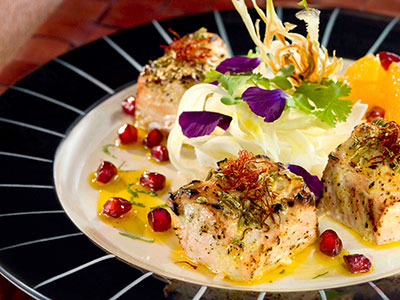
Casa Don Alfonso
Located at the Grand Lisboa, this is the top choice for authentic Italian food. With its stylish, contemporary interior and exceptional wine list you’ll want to linger. One bite from the margherita pizza and you’ll be transported to Naples.
Where to shop in Macau
Hong Kong is renowned as a shopping destination but few people realise that Macau boasts a multitude of stores from global designers and brands, placing it in the same league. Shopping is so beloved by locals and tourists alike there is even an annual Macau Shopping Festival.
First stop (and possibly the last as it’s so massive) is Shoppes at Venetian. The Venetian Macao opened in 2007 and is the largest integrated resort of its kind in Asia.
Along with the 3000-suite hotel, sport, convention and conference centres and live concert areas and gaming spaces, it also has more than 30 restaurants, over 350 stores and a food court that can seat 1000. The complex includes replica architectural icons and canals from its Italian namesake. Should you want a break from the shops, take a ride in one of the 44 genuine Italian gondolas, which come complete with singing gondoliers. Brands stocked at Shoppes at the Venetian include everything from high-end labels Prada and Dior to streetwear brands such as Fred Perry and Ed Hardy. Shoppers can also connect with Shoppes at Four Seasons, Shoppes at Cotai Central and Shoppes at Parisian meaning you have access to 850 stores. This is shopping on steroids so set aside plenty of time, wear comfortable shoes and leave your own trail of breadcrumbs because it’s really easy to get lost.
Getting there
For Kiwis, the most direct route is to fly into Hong Kong International Airport and catch a ferry – which is located in the same complex – directly to Macau. This means you are not required to enter Hong Kong. Alternatively, if Hong Kong is your destination, make sure to tack on a few nights in your itinerary to make it to Macau. dish flew with Hong Kong Airlines, which departs daily from Auckland International Airport.
Entertainment in Macau
In the same vein as Las Vegas, shows are a big thing in Macau. And the quality of many will match anything you’ll see on any stage around the world. Staggered starts and tight run times make for great pre-dinner entertainment.
The Monkey King Show
Based on the quirky tale from Chinese folklore, this appeals to both children and adults alike, ensuring packed audiences. It’s a mix of acrobatics, dance, martial arts and ‘high-tech effects’. The costumes are extraordinary.
The House of Dancing Water Show
The House of Dancing Water Show combines acrobatics, dancing, circus artists and daring motorcycle acts all on a water stage in a show suitable for the whole family.
La Parisienne Cabaret Francias
The line-up for this exhilarating show includes cancan dancers, ice skaters, illusionists and death-defying motorcycle stuntmen.

latest issue:
Issue #120
As the days become shorter, and the nights cooler, the latest issue is perfectly timed to deliver delicious autumn dishes. From recipes using fresh seasonal produce such as feijoas and apples, to spectacular soothing soups and super-quick after-work meals in our Food Fast section, we’ve got you covered. With Easter on the horizon, we feature recipes that will see you through breakfast, lunch and dinner over a leisurely weekend holiday, and whip up chocolatey baking treats sure to please. We round up delicious dinners for two and showcase a hot new Korean cookbook before heading south to Dunedin to check out all that’s new in food and dining.The latest issue of dish is on sale NOW at all good bookstores and supermarkets – don’t miss it!

